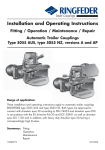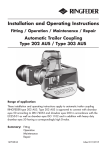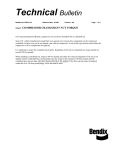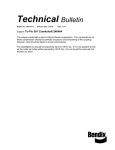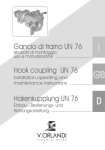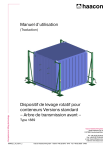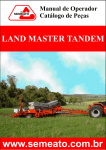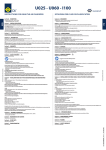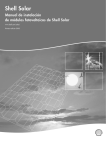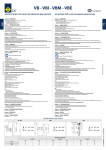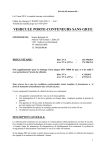Download Installation and Operating Instructions
Transcript
204-07_Aus_Type 101 04.18.2007 16:12 Uhr Seite 1 Trailer Couplings Installation and Operating Instructions Fitting / Operation / Maintenance / Repair Automatic Trailer Coupling Type 101 AUS Range of application: These installation and operating instructions apply to automatic trailer coupling RINGFEDER type 101 AUS. Type 101 AUS is approved to connect with drawbar eyes 50 according to DIN 74053 and drawbar eyes D50 in accordance with the EU directive 94/20 and ECE55-01 as well as drawbar eyes ISO 1102 and in addition with heavy duty drawbar eyes 50 having a correspondingly high D-value. Summary: Fitting Operation Maintenance Repair 10069949 04/2007 204-07_Aus_Type 101 04.18.2007 16:12 Uhr Seite 2 Installation 1. Remove castle nut (42). 2. Pull tension washer (40), rubber spring (36) and bar guide (38) from the drawbar (1). 3. Fit bar guide (38) contrary to the driving direction to the inner face of the rear drawbeam. Caution: Max thickness of the drawbeam: 35 mm! 4. Tighten the bar guide (38) together with the drawbeam using 4 bolts grade 8.8 and 4 safety nuts grade 8. The heads of the screws have to be mounted on the side of the coupling head (outer side of the drawbeam). Under screws and nuts you have to use washers DIN 125, hardness min 200HV. Bolt length: bolt shank + washer thickness + nut length + at least 2 threads Flange Design e1xe2 [mm] d2 [mm] Thread (standard thread) Tightening Torque Wrench Size [mm] 160 x 100 Ø 21 M20 410 Nm 30 5. Fit tension washer (40) without any other components of the towing device to the bar guide (1) and fully tighten the castle nut (42) by hand. Measure the dimension X (see figures 1 – 4). Remove castle nut (42) and tension washer (40) again. 6. Fit the coupling head assembly including the front rubber spring (36) and thrust washer (37) to the bar guide (38). If required, regrease drawbar (1) and contact surfaces of thrust washer (37) and bar guide (38). Caution: Never grease the rubber spring! 7. Fit the rear rubber spring (36) and tension washer (40). Caution: Never grease the rubber spring! 8. Grease the contact surfaces of the castle nut (42) and tension washer (40). Screw on and tighten the castle nut (42) until the previously measured dimension X is reached again and secure by means of a cotter pin (43). Min. tightening torque of the castle nut M45x3: 700 Nm using a wrench or nut with a wrench size of 70 mm. To reach the dimension X and the next hole position for the cotter pin even higher tightening torques may be required. Caution: Always tighten to the next hole position. 2 9. Fit and push on the protective plastic cap (44) carefully. 10. Straighten the coupling. 11. For a retro-fit please refer to the relevant statutory regulations. 204-07_Aus_Type 101 04.18.2007 16:12 Uhr Seite 3 Figures 1-4 3 204-07_Aus_Type 101 04.18.2007 16:12 Uhr Seite 4 Operation 1. The trailer coupling is closed and secured, resp. coupled that is to say the towing eye is inserted, the coupling bolt in its lower position, the safety device is engaged, the safety bar/bolt locates over the coupling bolt, the securing knob is in its internal engaged position. 2. Releasing and opening of the trailer coupling: The coupling can only be opened when the coupling jaw is in the central position or in the lateral end positions. To release the trailer coupling the securing knob is pulled out and turned ahead until it has reached its external engaged position. The trailer coupling now is released (Fig. 1). To open the coupling the hand lever is moved to its upper end position and then released. This will cause the coupling bolt to lift up and the towing eye may be extended. Due to the extension of the towing eye the coupling mechanism is again released and thus the coupling repeatedly closed and secured. 3. Opening the trailer coupling to couple the towing eye: To open the trailer coupling proceed as described under item 2 above. The coupling lever is in its upper end position, the coupling is set ready for its next engagement. When inserting the towing eye, the coupling mechanism is released by lifting the coupling bolt. The coupling closes automatically, which means that the coupling bolt is inserted through the towing eye bush in its lower position in the guide bush. The safety device is engaged, that is to say that the safety bar/bolt locates over the coupling bolt, the securing knob is in its internal engaged position, the coupling is closed and secured, the towing eye is engaged (Fig. 2). Check that after each coupling process the safety device is fully engaged. If the securing knob is not in its internal engaged position, the trailer coupling is unsecured and the whole procedure must be repeated. Fig. 1 Trailer coupling disengaged/uncoupled 4 Fig. 2 Trailer coupling closed and secured 204-07_Aus_Type 101 04.18.2007 16:12 Uhr Seite 5 Service and maintenance It is most important to always realize that the trailer coupling is a safety part and be handled as such. Regular service, maintenance and lubrication is a prerequisite for a safe and long-term troublefree service-life. The degree of loading and thus the wear of a trailer coupling also depend on the type of trailers, the loads, roads and climatic conditions. The wear limits given under „safety check“ must not be fallen short of ( for example coupling bolt diameter) nor exceeded (for example bore hole diameter bottom guide bush). If daily inspection of the vehicle in operation shows that the function of the trailer coupling has been impaired or strong signs of wear are sensible it is imperative that a safety check as described below be carried out immediately and, if necessary, the specific wearing parts be exchanged. In order to limit the degree of wear on the coupling bolt and drawbar eye bush these components must always be kept clean and lubricated. In case of hard running of the coupling mechanism the coupling head has to be lubricated over the tapered grease nipple (5). The trailer coupling should as far as possible not be cleaned by a steam cleaner (high pressure cleaner). If this cannot be avoided the trailer coupling itself should be closed beforehand. After such cleaning the bearings of the coupling body should be greased with WD40 or a similar high-grade permanent lubricant. After that also the coupling bolt is to be greased and the coupling head be lubricated over the tapered grease nipple (5). Safety check On its safety check the trailer coupling is to be inspected as described below: Functional check by repeatedly opening and closing the coupling. 1. Clean coupling bolt (23) and measure its smallest outside diameter in the bulged area. Wear limit of coupling bolts (in accordance with ISO-standard) 50 mm bolt couplings: 46,5 mm Should the wear limit be reached the coupling bolt and the pertaining locking springs (25), included in the delivery of the coupling bolt have to be replaced by new ones. 2. Measure axial play of the coupling bolt (23). For this purpose close the trailer coupling and push the coupling bolt from underneath upward by means of an appropriate tool. If the axial play should exceed 5 mm the hand lever/locking lever assembly has to be replaced. 3. Control clearance of the coupling bolt (23) in the bottom guide bush (6). The maximum admissible clearance must not exceed 2,5 mm. If necessary, the coupling bolt plus pertaining locking springs (25) or the bottom guide bush, resp. or both have to be replaced by new ones. Control max. diameter of the bottom guide bush (6) in the area of the coupling bolt seat e.g. by means of a slide gauge. Admissible inner dia: max. 36,5 mm Should the wear limit be reached the bottom guide bush has to be replaced by a new one. 5 204-07_Aus_Type 101 04.18.2007 16:12 Uhr Seite 6 4. Control bearing clearance of the drawbar (1) in the drawbar guide (38). Should the clearance between drawbar shaft and bearing bush (39) exceed 1 mm the plastic bearing bushes (39) in the bar guide (38) have to be replaced. Together with these also the rubber springs (36) should be replaced by new ones. 5. Control wear of the wear plate (7). The wear plate should be kept cleanest possible and free from grease, as grease consolidates dust and thereby the wear considerably increases due to the abrasive effect in trailer operation. If the wear plate shows strong signs of wear and tear (4 mm and more) it has to be replaced by a new one. 6. Control axial play (longitudinal play) of the bearing. For this purpose vigorously move the drawbar (not the guiding funnel of the mouth) back and forth in longitudinal direction using both hands. There must not be any axial play (longitudinal play) between the drawbar (1) and the bar guide (38), otherwise the rubber springs (36) have to be replaced. When replacing the rubber springs, at the same time the plastic bearing bushes (39) in the bar guide (38) have to be exchanged as well. 7. Control pivot bearing of the coupling body (3) for longitudinal play. maximum admissible longitudinal play at the upper bearing: 1 mm maximum admissible longitudinal play at the lower bearing: 1 mm When the maximum admissible bearing clearances have been reached the trailer coupling must be repaired. 8. Control coupling body (3) for smooth running. For this purpose move coupling body with the trailer coupling closed to the right and to the left. In case of stiffness the bearings of the coupling body have to be roughly cleaned and greased with WD 40 or a similar high-grade permanent lubricant so that the coupling mouth is smoothly running. By the force of the return spring the coupling body must automatically return / recoil into its central position. Important note: To fix the castellated nut with a cotter pin attend to always using new, corrosion-resisting cotter pins. Moreover, when replacing component parts of the trailer coupling only original RINGFEDER spare parts are to be used, since otherwise a safe performance cannot be safeguarded and every guarantee ceases. max. 4mm Pivot bearings of the coupling body 5 6 1 4 2 3 6 (7,8) 204-07_Aus_Type 101 04.18.2007 16:12 Uhr Seite 7 Repair Disassembly from the vehicle 1. Remove protecting cap (44) (fig. 1). 2. Remove cotter pin (43) (fig. 2). 3. Unscrew castellated nut (42) (fig. 3). 4. Completely pull out coupling head from the bar guide (38) (fig. 4). 5. Remove tension washer (40) and rubber spring (36) from the bar guide (38). 6. Remove thrust washer (37) and rubber spring (36) from the drawbar shaft (fig. 4). Stripping down of the coupling head 1. Detach and remove fastening parts (32 – 34 and (9) of the top cap (26) (fig. 5). 2. Disassemble locking springs (25) and coupling bolt (23) including lifting sleeve (24) (fig. 6/7). 3. Remove wear plate (7) from the coupling mouth. 4. Detach hexagonal screws (14) at the tab washer (12) (fig. 8). 5. Remove tab washer (12) and return spring (11) (fig. 8). 6. Remove bottom guide bush (6) (fig. 9). 7. Remove coupling body (3) with the remaining fitted parts from the drawbar (1) (fig. 10). 8. Remove top guide bush (2) (fig. 11). Assembly of the coupling head 1. Drive in top guide bush (2) to the drawbar (1) (fig. 11). 2. Fit coupling body (3) on to the drawbar (1) (fig. 10). 3. Grease bottom guide bush (6) and drive through coupling mouth into the draw bar. (The threaded holes of the bottom guide bush must be transverse to the longitudinal axis of the coupling) (fig. 9). 4. Insert return spring (11) (fig. 8). 5. Screw on tab washer (12) (fig. 8). 6. Insert wear plate (7) in coupling mouth and screw up. 7. Insert coupling bolt (23) including lifting sleeve (24) the way that the axis of the pin (24) is transverse to the longitudinal axis of the coupling (fig. 7). 8. Insert locking springs (25) (fig.6). 9. Fill in new grease into the housing. 10. Refit top cap (26) and screw up (fig. 6). 11. Slip on rubber spring (36) and thrust washer (37) to the drawbar (1) (fig. 5). 12. Grease drawbar shaft. Assembly to the vehicle: 1. Grease bearing surface of the thrust washer (37) on the bar guide (38). 2. Fit tension washer (40) without any other components of the towing device to the bar guide (1) and fully tighten the castellated nut (42) by hand. Measure the dimension X (see figures 1 – 4). Remove castellated nut (42) and tension washer (40) again. 3. Fit the complete coupling head assembly to the bar guide (38) (fig. 4). 4. Slip on rubber spring (36) and tension washer (40) to the drawbar shaft. 5. Screw on castellated nut (42) and tighten according to "fitting instructions - item 8" (fig. 3). 7 204-07_Aus_Type 101 6. 7. 8. 04.18.2007 16:12 Uhr Seite 8 Drive in new cotter pin (43) and secure properly (fig. 2). Slip on protecting cap (44) (fig. 1). If necessary, adjust coupling head horizontally to the vehicle by using a lever. Caution: Never grease the rubber springs! Important Note: To fix the castellated nut with a cotter pin attend to always using new, corrosion-resisting cotter pins. Moreover, when replacing component parts of the trailer coupling only original RINGFEDER® spare parts are to be used, since otherwise a safe performance cannot be safeguarded and every guarantee ceases. 8 204-07_Aus_Type 101 04.18.2007 16:12 Uhr Seite 9 9 204-07_Aus_Type 101 10 04.18.2007 16:12 Uhr Seite 10 204-07_Aus_Type 101 04.18.2007 16:12 Uhr Seite 11 Trailer Couplings A certified company in accordance with DIN EN ISO 9001:2000 and ISO TS 16949:2002 and DIN EN ISO 14001:1996 VBG GROUP TRUCK EQUIPMENT GMBH Oberschlesienstr. 15 · D-47807 Krefeld · Postfach/POB 13 06 55 · D-47758 Krefeld Phone +49 (0) 21 51 8 35-0 · Facsimile +49 (0) 21 51 8 35-200 www.ringfeder.de · [email protected] 11 04.18.2007 16:12 Uhr Seite 12 Trailer Couplings 204-07_Aus_Type 101












